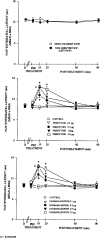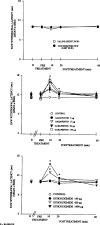Potent analgesic effects of anticonvulsants on peripheral thermal nociception in rats
- PMID: 12970103
- PMCID: PMC1574030
- DOI: 10.1038/sj.bjp.0705434
Potent analgesic effects of anticonvulsants on peripheral thermal nociception in rats
Abstract
1. Anticonvulsant agents are commonly used to treat neuropathic pain conditions because of their effects on voltage- and ligand-gated channels in central pain pathways. However, their interaction with ion channels in peripheral pain pathways is poorly understood. Therefore, we studied the potential analgesic effects of commonly used anticonvulsant agents in peripheral nociception. 2. We injected anticonvulsants intradermally into peripheral receptive fields of sensory neurons in the hindpaws of adult rats, and studied pain perception using the model of acute thermal nociception. Commonly used anticonvulsants such as voltage-gated Na+ channel blockers, phenytoin and carbamazepine, and voltage-gated Ca2+ channel blockers, gabapentin and ethosuximide, induced dose-dependent analgesia in the injected paw, with ED50 values of 0.30, 0.32 and 8, 410 microg per 100 microl, respectively. 3. Thermal nociceptive responses were not affected in the contralateral, noninjected paws, indicating a lack of systemic effects with doses of anticonvulsants that elicited local analgesia. 4. Hill slope coefficients for the tested anticonvulsants indicate that the dose-response curve was less steep for gabapentin than for phenytoin, carbamazepine and ethosuximide. 5. Our data strongly suggest that cellular targets like voltage-gated Na+ and Ca2+ channels, similar to those that mediate the effects of anticonvulsant agents in the CNS, may exist in the peripheral nerve endings of rat sensory neurons. Thus, peripherally applied anticonvulsants that block voltage-gated Na+ and Ca2+ channels may be useful analgesics.
Figures



Similar articles
-
Gabapentin decreases membrane calcium currents in injured as well as in control mammalian primary afferent neurons.Reg Anesth Pain Med. 2002 Jan-Feb;27(1):47-57. doi: 10.1053/rapm.2002.29124. Reg Anesth Pain Med. 2002. PMID: 11799505
-
Changes in expression of voltage-dependent ion channel subunits in dorsal root ganglia of rats with radicular injury and pain.Spine (Phila Pa 1976). 2002 Jul 15;27(14):1517-24; discussion 1525. doi: 10.1097/00007632-200207150-00007. Spine (Phila Pa 1976). 2002. PMID: 12131710
-
The antihyperalgesic effects of the T-type calcium channel blockers ethosuximide, trimethadione, and mibefradil.Eur J Pharmacol. 2005 Oct 3;521(1-3):79-85. doi: 10.1016/j.ejphar.2005.08.017. Epub 2005 Sep 19. Eur J Pharmacol. 2005. PMID: 16171802
-
Antiepileptic drug mechanisms of action.Epilepsia. 1995;36 Suppl 2:S2-12. doi: 10.1111/j.1528-1157.1995.tb05996.x. Epilepsia. 1995. PMID: 8784210 Review.
-
Gabapentin use in neuropathic pain syndromes.Acta Neurol Scand. 2000 Jun;101(6):359-71. doi: 10.1034/j.1600-0404.2000.0006a.x. Acta Neurol Scand. 2000. PMID: 10877151 Review.
Cited by
-
The antinociceptive effect of systemic gabapentin is related to the type of sensitization-induced hyperalgesia.J Neuroinflammation. 2007 Jun 5;4:15. doi: 10.1186/1742-2094-4-15. J Neuroinflammation. 2007. PMID: 17550605 Free PMC article.
-
Phenytoin Decreases Pain-like Behaviors and Improves Opioid Analgesia in a Rat Model of Neuropathic Pain.Brain Sci. 2023 May 25;13(6):858. doi: 10.3390/brainsci13060858. Brain Sci. 2023. PMID: 37371338 Free PMC article.
-
Novel neuroactive steroid with hypnotic and T-type calcium channel blocking properties exerts effective analgesia in a rodent model of post-surgical pain.Br J Pharmacol. 2020 Apr;177(8):1735-1753. doi: 10.1111/bph.14930. Epub 2020 Jan 23. Br J Pharmacol. 2020. PMID: 31732978 Free PMC article.
-
Inhibition of multiple voltage-gated calcium channels may contribute to spinally mediated analgesia by epipregnanolone in a rat model of surgical paw incision.Channels (Austin). 2019 Dec;13(1):48-61. doi: 10.1080/19336950.2018.1564420. Channels (Austin). 2019. PMID: 30672394 Free PMC article.
-
TTA-P2 is a potent and selective blocker of T-type calcium channels in rat sensory neurons and a novel antinociceptive agent.Mol Pharmacol. 2011 Nov;80(5):900-10. doi: 10.1124/mol.111.073205. Epub 2011 Aug 5. Mol Pharmacol. 2011. PMID: 21821734 Free PMC article.
References
-
- BAKER M.D., WOOD J.N. Involvement of Na+ channels in pain pathways. TIPS. 2001;22:27–31. - PubMed
-
- CARLTON S.M., ZHOU S. Attenuation of formalin-induced nociceptive behaviors following local peripheral injection of gabapentin. Pain. 1998;76:201–207. - PubMed
-
- CARLTON S.M., ZHOU S., COGGESHALL R.E. Peripheral GABAA receptors: evidence for peripheral primary afferent depolarization. Neuroscience. 1999;93:713–722. - PubMed
-
- CODERRE T.J., KATZ J., VACCARINO A.L., MELZACK R. Contribution of central neuroplasticity to pathological pain: review of clinical and experimental evidence. Pain. 1993;52:259–285. - PubMed
Publication types
MeSH terms
Substances
Grants and funding
LinkOut - more resources
Full Text Sources
Other Literature Sources
Miscellaneous

